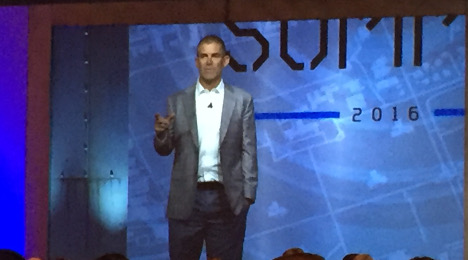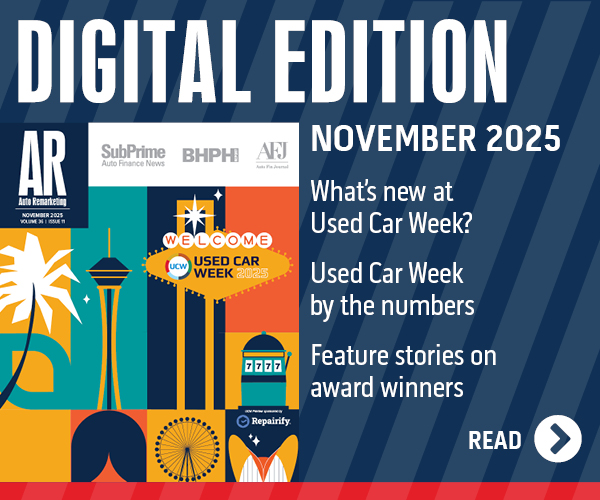DealerSocket CEO on digital retail: ‘The wave is coming’

DealerSocket chief executive officer Jonathan Ord, during the company's User Summit in San Antonio.
By subscribing, you agree to receive communications from Auto Remarketing and our partners in accordance with our Privacy Policy. We may share your information with select partners and sponsors who may contact you about their products and services. You may unsubscribe at any time.
SAN ANTONIO –
The way dealers used to work with car shoppers often made the latter feel prodded and herded like cattle, says DealerSocket chief executive officer Jonathan Ord.
Speaking at his company’s User Summit in Texas (and using regionally apt metaphors), Ord recommended dealers let consumers steer the purchase method decision-making, whether that’s online, in-store or a mix of both.
“We see this more as a great field for cows,” Ord said, extending the metaphor. “And some of these cows are coming up to each other and saying, ‘Hey, you know what? There is some great alfalfa over there in that corner. I know how you like alfalfa.’ … And your customers are bringing the other cows along.”
Point is, rather than forcing the customer to go the way the dealership wants him or her to go, the store must facilitate a process that lets the shopper choose.
And these days, the amount of choice is only increasing, as direct-to-consumer and peer-to-peer car-buying resources dot the landscape.
Or, to use parlance closer to DealerSocket’s home in Southern California, “I can tell you the wave is coming,” Ord said.
Subscribe to Auto Remarketing to stay informed and stay ahead.
By subscribing, you agree to receive communications from Auto Remarketing and our partners in accordance with our Privacy Policy. We may share your information with select partners and sponsors who may contact you about their products and services. You may unsubscribe at any time.
“And many of our dealers are not ready for the wave that is coming,” he said. “I mentioned Beepi and Carvana and Vroom. The next step of that is Amazon and Google Auto.”
And those players find auto retail to be a major opportunity, with a great deal of money being exchanged. After all, Ord said, it’s typically the second-largest purchase people make — and they make it several times throughout their lifetimes.
“The people that own the consumer relationship would love to have a piece of this business,” Ord said. “Now, it’s our responsibility to make sure that we make the transaction as easy as possible for the consumer, and let them do that transaction in any way that they want to.”
Whether that means the shopper wants to go the traditional route or, say, complete half the deal online then head to the store to work with a salesperson they trust, dealers should facilitate that, he said.
Or, if they want the transaction to be entirely online with the dealership delivering the car to their house, “Great, we want to be able to do that.”
‘More time focused on what customer wants’
The company’s new Blackbird platform that incorporates both CRM and DMS technology — unveiled at the User Summit — may help facilitate that process Ord describes.
Blackbird is an integrated technology platform that can be thought of as “an enabler” of various products, even beyond CRM, DMS or inventory management, DealerSocket vice president of product strategy Jennifer Lee said during a media roundtable at the event.
“We believe that less time in front of a keyboard and more time with the customer is most important,” Lee said.
“Consumers want a personalized experience. So we didn’t want a CRM that was going to tie them to their desktop in order to do their jobs,” she said. “Between the mobile changes that we’ve made in the last year and simplifying the process for them to do their work, we’re hoping to facilitate more time spent with their customer, more time focused on what the customer wants and how the customer wants to do business.”
And this launch was just the beginning. In fact, one of the additions for Blackbird that DealerSocket has planned is a digital retailing solution, set to launch in the first quarter. Lee said the company is currently in the engineering phase.
‘Make sure processes and trust are in place’
There is somewhat of a dichotomy between perceptions of auto ecommerce, DealerSocket director of business development Nathan Usher said during the roundtable, where he discussed the company’s latest Dealership Action Report.
Car shoppers certainly flock to the web. However, 67 percent of consumers still aren’t ready to finalize the transaction online, the report indicated.
Yet, dealers believe that 66 percent of consumers only want to buy online.
That lends itself to the notion that, perhaps, 100-percent online retail is “not a silver bullet,” Usher said.
“There’s still the human element, (where) they want a demo, they want to get access to the dealership and they want to get a fair price and customer service,” he said. “Now, is the industry going into a digital retail experience? Absolutely. There’s no question.”
Usher said the innovation of online car-buying is exciting, but emphasizes that the data shows the majority of consumers aren’t quite ready for buying a car completely online.
“We want to be there as well, but we’ve got to grow smart and effectively when it comes to the (digital) retail experience,” he said. “I’ll be the first to admit that I love that topic … but we still have to realize that there are still a lot of consumers out there that still are not ready, so it’s not a silver bullet there.
“We’re preparing for that, but we still have to make sure that the processes and the trust are in place, because unless you have the trust, they’re still not going to go to your dealership and buy online.”
And as Ord emphasized previously, it’s about allowing the customer to go as far as they would like online and facilitating that process by presenting them with the information and research, Usher said.
Dealers have seen the disruptors who have provided this to consumers and made moves to adapt; and who better to offer that to consumers than dealers?
“Dealers have the advantage. They have all the connections. They have all the inventory. They have all the processes,” Usher said. “We can enable them to have that (online retail) experience and have the traditional roots of the dealership process in place. It’s a win-win.”
However, he added, “they still have to adopt it” and understand that the digital retail experience and customer service experience must be combined. In other words, you can’t neglect what happens at the dealership level, Usher said.
“If I couple both of them together,” he said, “then it’s a successful dealership.”


